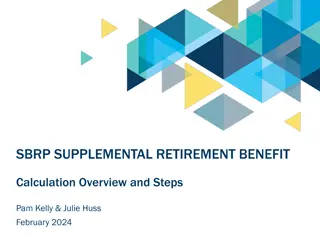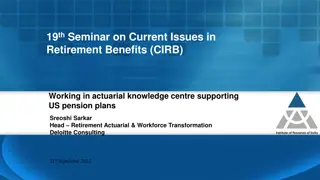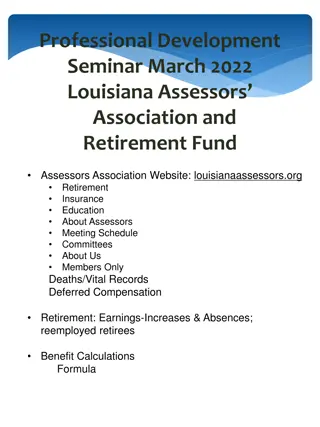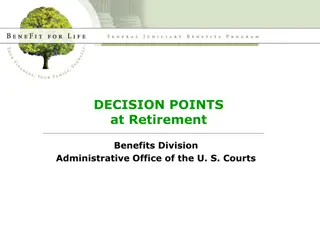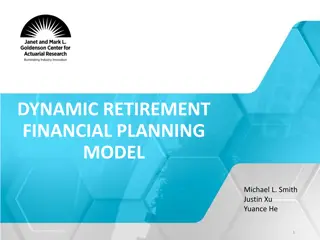Current Landscape of Retirement Benefits in India
This online series delves into the 18th current issues in retirement benefits in India, discussing pension coverage, regulatory frameworks, market trends, and investment landscapes. Insights from industry experts shed light on the structure of the pension market, key players, and emerging trends shaping retirement benefits in the country.
Download Presentation

Please find below an Image/Link to download the presentation.
The content on the website is provided AS IS for your information and personal use only. It may not be sold, licensed, or shared on other websites without obtaining consent from the author.If you encounter any issues during the download, it is possible that the publisher has removed the file from their server.
You are allowed to download the files provided on this website for personal or commercial use, subject to the condition that they are used lawfully. All files are the property of their respective owners.
The content on the website is provided AS IS for your information and personal use only. It may not be sold, licensed, or shared on other websites without obtaining consent from the author.
E N D
Presentation Transcript
18th Current Issues in Retirement Benefits Online Series August 2021
Introduction Mute Q&A IAI support CPD Recording Feedback www.actuariesindia.org
18th Current Issues in Retirement Benefits(CIRB) Online Series August 2021 11 August 2021 Investments landscape in India (Retirement Benefits) Attish Yagnik - Mercer India
Speaker Introductions Attish Yagnik Senior Associate - India Investments, Mercer India Current role: Lead the investment advisory team Involved in security selection, credit analysis, portfolio construction and churning recommendations Oversee a team of analysts who together advise ~ 50 Pension & Institutional funds Prior experience: Debt Capital Markets with L&T Infrastructure Finance Credit & Fixed Income Markets with Edelweiss Analyst with India Life Capital Wealth Management Banking Sector www.actuariesindia.org
Contents Pension coverage in India Regulatory landscape Market landscape Current trends in the segment Market outlook www.actuariesindia.org
Pension coverage in India Structure of Pension Market Universal Social Security Old DB Schemes Occupational Pension Personal Pension NPS for Corporate, NPS Lite Central / State Govt s. Central schemes EPFO. Mutual funds PSUs State schemes Exempted / Excluded EPF, SAF, GF Trusts Insurance Plans Estimated Market share: ~ 3.5% Estimated Market share: ~ 0.5% Public Deposits NPS for Govt. employees Estimated Market share: ~ 14% Estimated Market share: ~ 82% Source: Ministry of Labour, PFRDA & Open source data www.actuariesindia.org
Regulatory landscape: EPF, SAF & GF Minimum Allocation Maximum Allocation Category Investment Category I Government Securities & Related Investments 45% 65% II Debt Instruments & Related Investments 20% 45% III Short-Term Debt Instruments & Related Investments 0% 5% IV Equities & Related Investments 5% 15% V Asset Backed, Trust Structured & Miscellaneous Investments 0% 5% Miscellaneous Conditions Source: Ministry of Labour www.actuariesindia.org
Regulatory landscape: NPS Max. Exposure Pvt. Max. Exposure Others. Scheme / Asset Class Category Investment Category I Government Securities & Related Investments 100% Up to 50% G II Debt Instruments & Related Investments 100% Up to 45% C III Equities & Related Investments 50% Up to 15% E IV Alternative Asset Class 5% Up to 5% A Temporary Allocation (< 5% of Scheme Corpus) V Short-Term Debt Instruments & Related Investments Miscellaneous Conditions Source: PFRDA www.actuariesindia.org
Market landscape 1.. Fixed Income Securities: Market Size (outstanding values, INR lakh crs) 68.6 62.2 57.5 53.2 35.6 34.1 32.7 32.5 30.7 27.8 27.4 24.3 9.8 5.4 4.2 3.9 FY 18 FY 19 FY 20 H1 FY 21 Central Govt. Securities T-Bills State Govt. Securities Corporate Bonds Source: SEBI,RBI,CCIL PSU AAA Corp AA+ 10Y G-Sec Benchmark 6.4% Corp A / A- Corp Corp AAA AA/AA-/A+ SDL +70 bps +25 bps +20 bps +25 bps +35 bps +90 bps +60 bps Yield Indicative spreads on Fixed Income Securities www.actuariesindia.org
Market landscape 2. Estimated Investment Allocation: EPF Estimated Investment Allocation: NPS State Government Securities Govt. Securities (G-Sec/SDL/T-bills) 52.4% 37.0% Corporate Bonds 23.1% Central Govt. Securities 15.2% Corporate Bonds 35.0% Public Account 11.3% Equity 10.4% Equity 7.7% Special Deposit Scheme 4.0% Mutual Fund Units 2.2% Government Guaranteed Securities 1.7% Amount (INR lakh Crs) Amount (INR lakh Crs) Estimated EPF Allocation Estimated NPS Allocation 0.24 0.55 1.06 1.56 2.09 3.18 5.09 13.76 Government Guaranteed Securities Special Deposit Scheme Equity Public Account Central Govt. Securities Corporate Bonds State Government Securities Total AUM Mutual Fund Units 0.09 Equity 0.42 Corporate Bonds 1.44 Govt. Securities (G-Sec/SDL/T-bills) 2.15 Total AUM 4.10 Source: PFRDA Data as on March 2020 Source: EPFO Data as on March 2020 www.actuariesindia.org
Current trends a. Transition from DB to DC plans gaining popularity Governance: Trusteeship, governance of plans are being re-defined in the context of sponsor risks and employee requirements Future of EPF Trusts: Sponsors and Trustees are increasingly going back to the board to understand the viability of the Trust format of Provident Fund Investments: Credit risk, earnings shortfalls and equities continue to confront exempt PFs and may accentuate in the post Covid-19 era. b. Thrust on reforms in the Indian Debt market Tighter norms for Credit Rating Agencies in terms of data disclosures and providing early warning signals to protect investor interests However, this may further impact investment diversification of long-term investors like Pension funds and Insurers given the limited options within the highly rated NCD segment Push towards uniform security level valuation of bonds given the different practices followed by some segments such as matrix-based pricing or held to maturity (HTM) valuations Regulatory and policy changes for creating institutional facilitations such as CDS, Corporate bond REPOS and trading to improve liquidity Raising of limits for FPIs and increased retail participation Bankruptcy reforms have led to material growth in the corporate bond markets c. Passive investments gaining momentum in Equity market Off late, it has been observed that not many active funds have been able to outperform the market. According to data from S&P Indices versus Active, approx. 80% of active funds underperformed the BSE 100 index. This is largely attributable to the following: Change in the categorization of schemes by SEBI restricted the universe of large caps Significant differential in expense ratios of active funds as against passives like Index/ETFs further add to the underperformance. This difference has been in the range of 1-2% or even more at times. The retiral benefit funds have also taken cue from the above developments and have gone the passive way of investing in Equities This trend is expected to continue given the wider market expectation that the large-cap companies may be in a better position to drive the near term recovery/ growth in economic activity; given the advantages they have of larger balance sheets, market share and buffers to absorb the Covid impact. www.actuariesindia.org
Market outlook Fixed Income: The debt market is in a cautious zone because the interest rates are expected to remain volatile due to RBI normalizing liquidity and upside risk to inflation due to economic recovery. Key points: a. RBI may have to support growth trajectory and on the other hand would need to keep an eye on upside risk to inflation. b. The growth recovery got disrupted due to the second wave, but it is expected to pick up. c. Inflation trajectory needs to be monitored closely. d. Market expects a gradual withdrawal of monetary stimulus. Equity: The current Equity valuations suggests that Equity investing can be looked at from a long-term perspective. Overall, the buoyance in the equity market has not been broad based and has been limited to large-caps & selective mid-cap stocks. Key points: a. Valuations are not cheap. b. Business Cycle is still in the early phase. c. Neither aggressive nor negative on equities: Middle-of-the-road approach. Pension funds: Given the recent credit crisis in the Indian Debt market, it is observed that besides Mutual Funds & Insurance Co s, most Government & Private Pension funds in India are impacted by defaults in their bond portfolio which has had a bearing on the earning potential of the funds. Key points: a. This has brought the Pension Fund Managers, Trustees & Sponsors back to the drawing board to relook at their investment policy and framework with an objective to strengthen the risk-management practices and optimize returns. b. Active management of funds could be a new normal which is contrary to the historical hold-to-maturity nature of these investors. www.actuariesindia.org
Annexure www.actuariesindia.org
Regulatory landscape: EPF, SAF & GF Regulatory Band Category Issuer of Instruments Type of Instruments Min. Max. I Government Securities & Related Investments Central Government State Governments State Owned PSUs Central Government Owned PSUs Fund Houses Debt Instruments & Related Investments PSUs, Banks and PFIs 1a 1b 1c 1d 1e II 2a GOI Securities, Special Bonds, GOI Treasury Bills State Development Loans State Government Guaranteed Bonds Central Government Guaranteed Bonds Gilt Mutual Funds 45.00% 65.00% Bonds (Listed or proposed to be listed) 2b Basel III Tier-I Bonds issued by Scheduled Commercial Banks Bonds (Listed or proposed to be listed) 2c 2d 2e Rupee Bonds issued by IBRD, IFC and ADB TDRs of Scheduled Commercial Banks Fund Houses Scheduled Commercial Banks, Body Corporates, IDF's of NBFC's & Fund Houses Short-Term Debt Instruments & Related Investments Bodies Corporate / Schedule Commercial Banks Fund Houses TDRs of Scheduled Commercial Banks Equities & Related Investments Listed Companies Fund Houses Bonds 20.00% 45.00% Term Deposit Receipts Debt Mutual Funds Bonds (Listed or proposed to be listed other than Bank bonds) , IDF Mutual Funds 2f III 3a 3b 3c IV 4a 4b Certificates of Deposits, Commercial Papers, Liquid Mutual Funds Term Deposit Receipts 0.00% 5.00% Shares of Companies (Listed on BSE or NSE) Equity Mutual Funds i. ETF (Listed on stock exchanges) ii. Index Funds (Listed on stock exchanges) ETF's constructed for disinvestments (Listed on stock exchanges) Exchange traded derivatives (Listed on stock exchanges) 4c Fund Houses 5.00% 15.00% 4d 4e Fund Houses Banks, Fund Houses V Asset Backed, Trust Structured & Miscellaneous Investments 5a 5b 5c 5d Body Corporates Real Estate Investment Trust's Body Corporates Infrastructure Investment Trust's Commercial / Residential Mortgage Based Securities Units of REIT'S Asset Backed Securities Units of Infra. Investment Trust's 0.00% 5.00% Back www.actuariesindia.org
Regulatory landscape: NPS Max. Exposure Pvt. Max. Exposure Others. Scheme / Asset Class Category Issuer of Instruments Type of Instruments I Government Securities & Related Investments Government Securities Central & State Government Owned PSUs Fund Houses Debt Instruments & Related Investments PSUs / PFIs, Banks and other Body Corporates Rupee Bonds issued by IBRD, IFC and ADB TDRs of Scheduled Commercial Banks Fund Houses Scheduled Commercial Banks, Body Corporates, IDF's of NBFC's & Fund Houses 1a 1b 1c II 2a 2b 2c 2d G-Secs (SLR/Non-SLR), SDL's (SLR/Non-SLR), GOI Treasury Bills Central & State Government Guaranteed Bonds Gilt Mutual Funds Up to 50% 100% "G" Bonds (Listed or proposed to be listed) Bonds Term Deposit Receipts Debt Mutual Funds Bonds (Listed ot proposed to be listed other than Bank bonds) , IDF Mutual Funds Bonds (Listed ot proposed to be listed other than Bank bonds) , IDF Mutual Funds Up to 45% 100% "C" 2e 2f State Municipal Bodies III 3a 3b Equities & Related Investments Listed Companies Fund Houses Shares of Companies (Listed on BSE or NSE) Equity Mutual Funds i. ETF (Listed on stock exchanges) ii. Index Funds (Listed on stock exchanges) ETF's constructed for disinvestments (Listed on stock exchanges) Exchange traded derivatives (Listed on stock exchanges) Up to 15% 3c Fund Houses 50% "E" 3d 3e IV 4a 4b 4c 4d 4e 4f Fund Houses Banks, Fund Houses Alternative Asset Class Body Corporates Body Corporates Real Estate Investment Trust's Infrastructure Investment Trust's Body Corporates Scheduled Commercial Banks Short-Term Debt Instruments & Related Investments (<5% of Scheme Corpus) Bodies Corporate / Schedule Commercial Banks Fund Houses TDRs of Scheduled Commercial Banks Commercial / Residential Mortgage Based Securities Asset Backed Securities Units of REIT'S Units of Infra. Investment Trust's Alternative Investment Funds (Cat. I & II) Basel III Tier-1 bonds 5% Up to 5% "A" V 5a 5b 5c Certificates of Deposits, Commercial Papers, Liquid Mutual Funds Term Deposit Receipts Temporary Allocation Back www.actuariesindia.org
Q&A www.actuariesindia.org
Thank you! CPD Questions See you later at 5.00pm www.actuariesindia.org



